Krakow is a pleasant, relatively inexpensive mid-size city with a population of 750,000. It turned out to be a bit more touristy than we had expected. One of the oldest cities in Poland, Krakow has a long history dating from the 9th or 10th century. Unlike Warsaw , where most of the Old Town was destroyed during World War II, Krakow’s Old Town has more preserved sights.
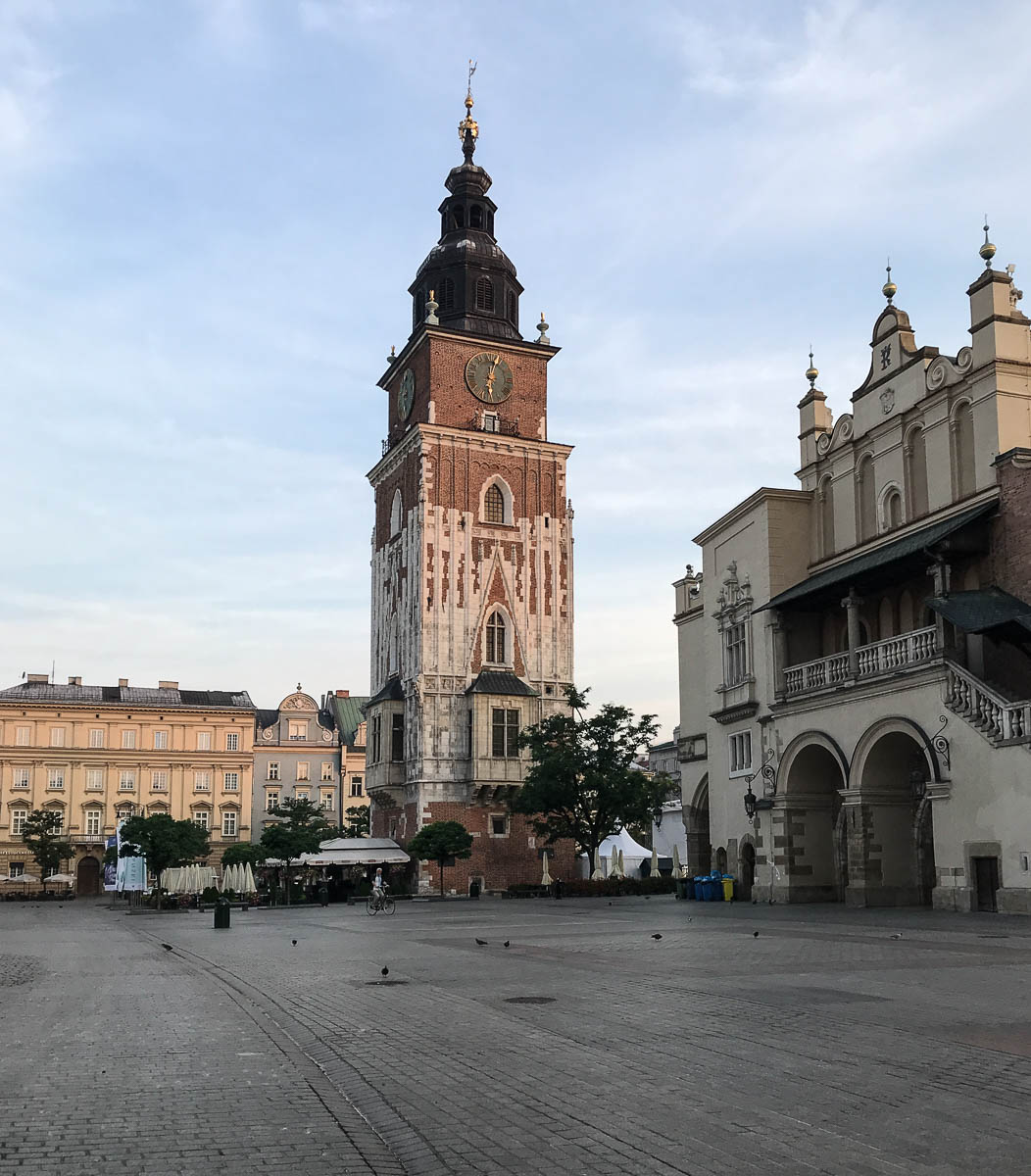
Warsaw to Krakow
As with most European countries, Poland has an extensive train system, thus giving us a choice of train types and times. Since we booked our tickets only one day before travel, the highspeed train, taking two and a half hours, was a bit pricey at $30 per person (my how our perspective has changed). Happily we were in no rush. We took the slower train which took five hours and “splurged” on 1st class (quite comfortable) for $15 per person.
Arrival in Krakow
To exit the train station, itself quite large, we had to maneuver through a big shopping mall. A pleasant welcome came from a well-meaning young man who approached us to offer advice on how to get to our apartment. When we told him that we were planning on walking, he insisted that one of the three or four different-number trams would be advisable. Thanking him, we took off and walked the 30 minutes to our apartment, providing our first glimpse of the lay of the land.
Our apartment was on a quiet street in a pleasant real neighborhood, yet just a 15-minute walk to Old Town. Just around a couple corners was the main business street with two 24-hour grocery stores, shops, restaurants, and several tram lines. During our stay in Krakow, we never took the tram, choosing to walk, despite the daily climb of 89 steps to reach our 4th (3rd in European jargon) floor apartment. Ann reflected on how by walking all the time, we missed this local transportation experience in several of the cities that we visited. Oh well, maybe a tram is a tram is a tram after all. We certainly got to see, hear, and stay out of the way of them.
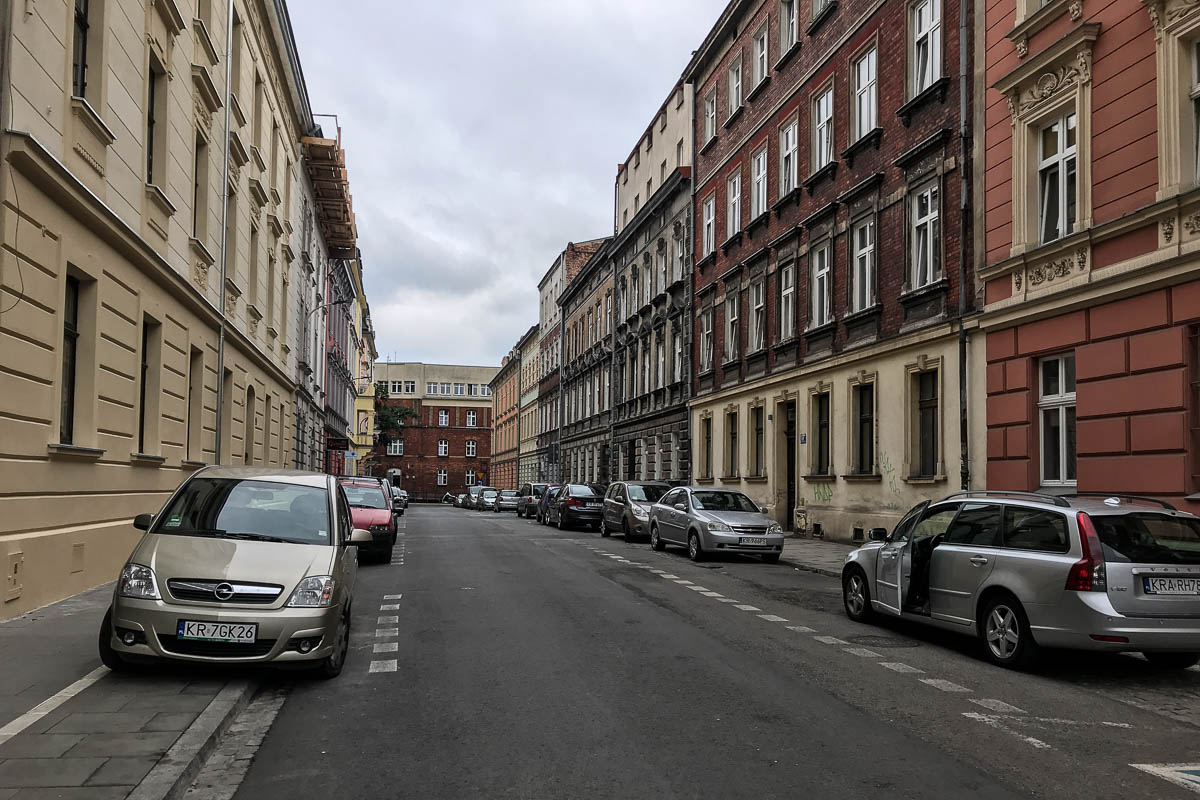
Our Daily Experiences
We spent a relaxing 16 days in our bright, comfortable Airbnb apartment, for which we paid $38 ($43 including fees) per night. Note: If we had booked far enough ahead we could have found an Airbnb for $700 month (about the same as Brasov). We took the opportunity to chill a bit in advance our last month in Europe before returning to the US.

We enjoyed walking, shopping, and occasionally dining out in our local neighborhood. It was a bit of a challenge at times as we were surprised by how many people, outside the tourist areas, had limited or no English. Forget trying to learn the Polish language. We were halfway through our 16-day stay before we mastered good day, dzień dobry, and thank you, dziękuję, pronounced something like jing kwee uh. That said, we found the local people to be quite friendly once you approached them first. On our three visits to the local market, we had vendors carrying on lengthy one-sided conversations with us in Polish.
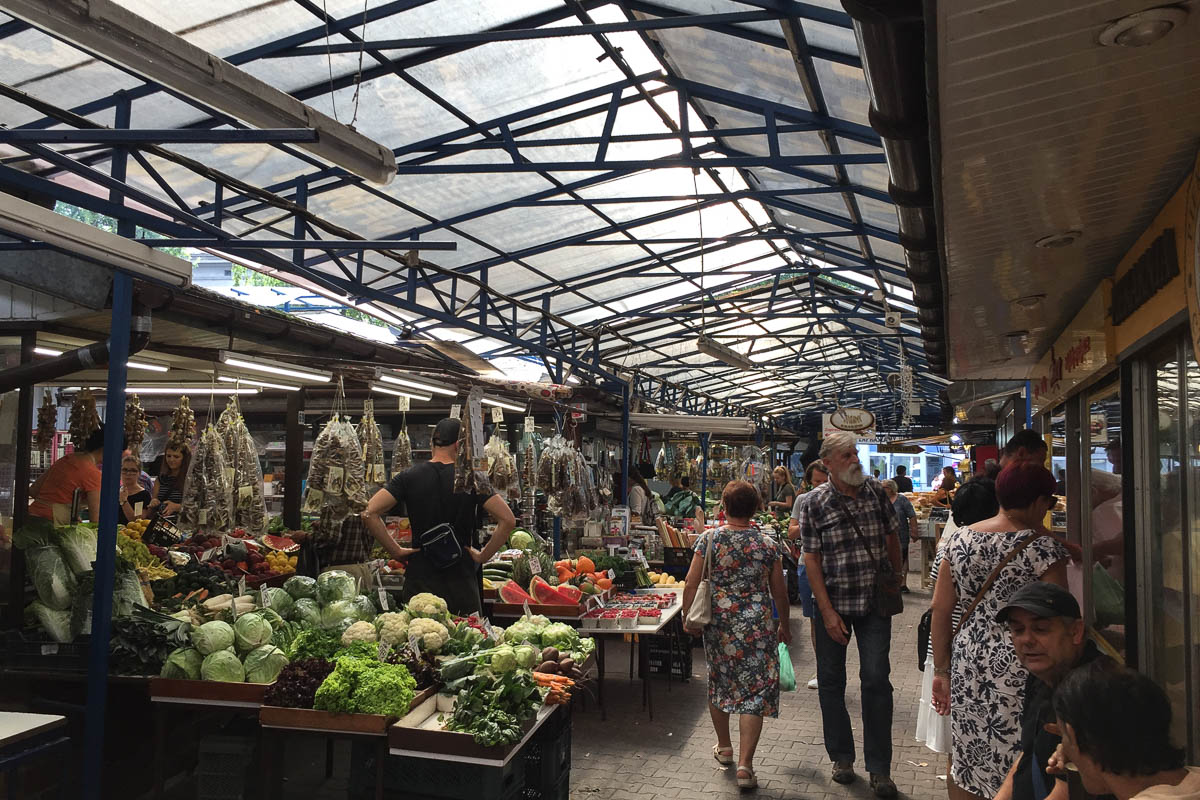
Krakow Free Walking Tours
In several of the cities, Barcelona, Valencia, Seville, Sarajevo, we’ve visited in Europe on this leg of our travels, we have taken advantage of the city’s “free” walking tours. Not actually free: the tour guides always tell us that we set the price, i.e., tip. While in Krakow, we did two free walking tours with Walkative!.
Old Town Krakow Walking Tour
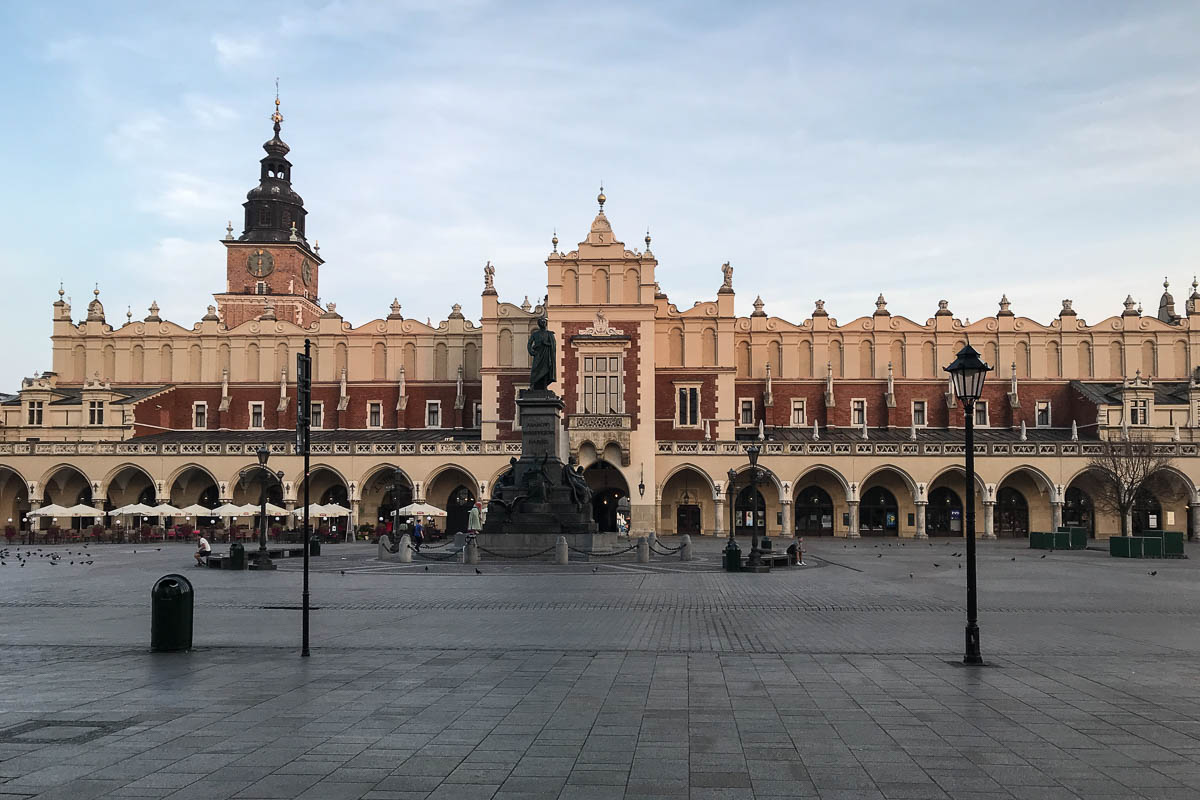
Much of Krakow’s Old Town, Stare Miasto, remains unchanged from medieval times other than the fact that large portions of many buildings are underground. Rather than repair old roads, new ones were simply built on top of old ones. Our tour began near St. Florian’s Gate and the Barbican. Royal processions passed through this gate on their way through the city to Wawel Castle (more on this later).
Krakow’s Main Square, Rynek Główny
The tour continued in the main square, Rynek Główny, one of the largest medieval town squares in Europe. Here we saw and learned about the Townhall Tower, the old Cloth Hall, and St. Mary’s Church. Every day on the hour, a bugle call is played in each of the four directions from one of the towers of St. Mary’s Church. The call is incomplete because story has it that a bugler was killed when sounding the call of an enemy approach.

The “Papal Window”
We continued past St. Francis Church, the Bishop’s Palace and its “papal window”. The palace has been home to Krakow’s bishops since the 14th century when it was built. Cardinal Karol Wojtyla lived there from 1958 to 1978, before he became Pope John Paul II. He is said to have made nightly appearances at this “papal window” whenever he returned for a visit to Krakow.
Before heading up Wawel Hill, we stopped at a park for a short talk. Our tour guide filled us in on life under Communism (he was 11 when the Communist regime fell), including food shortages. He also told us that three million Poles, one-tenth of the population were killed by Nazis, and one million more were killed by Stalin.
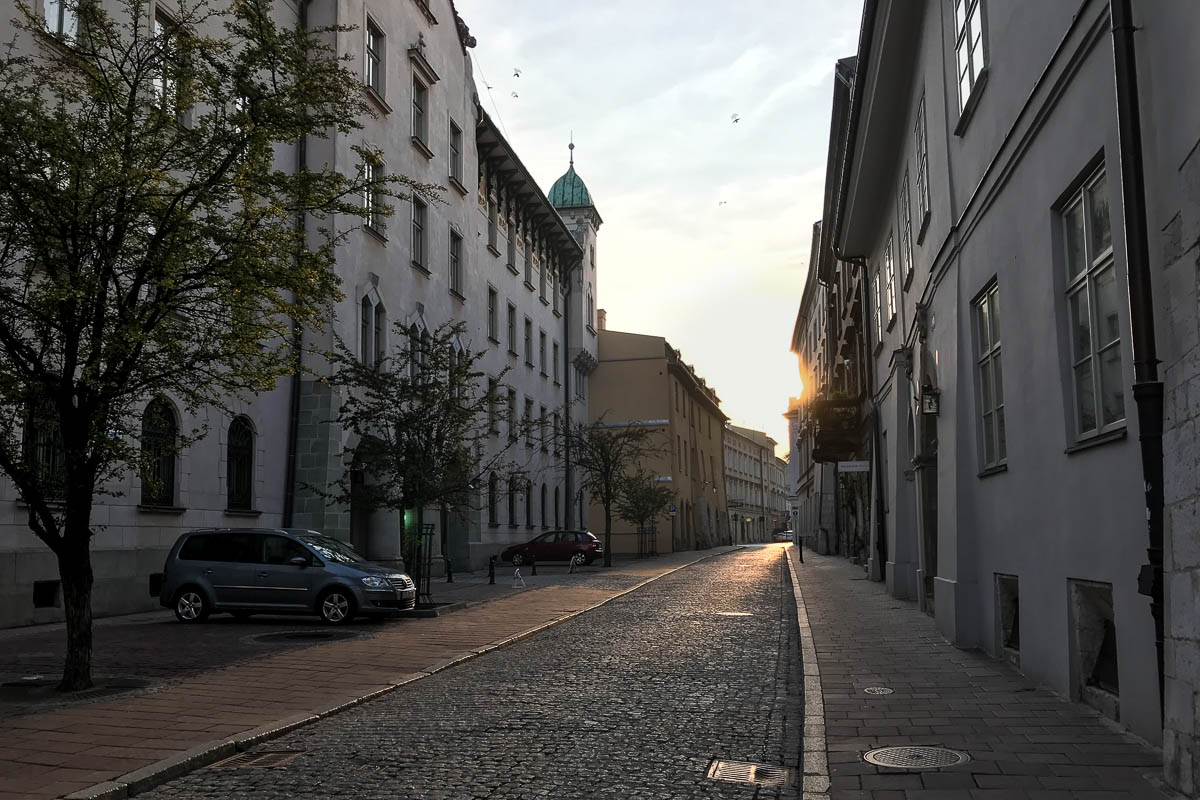
Wawel Hill
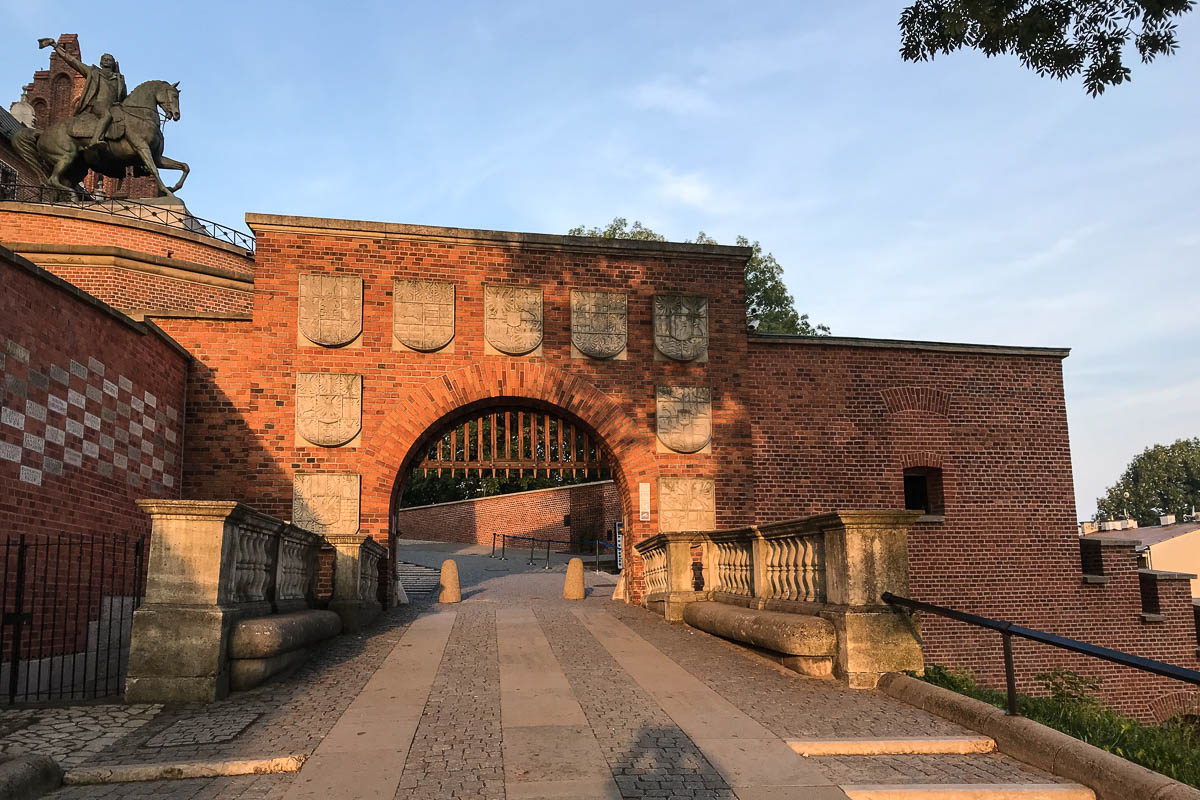
Wawel Castle, along with its attached cathedral, sits prominently overlooking the city on Wawel Hill. Just below the castle is part of the Planty, the former moat which today is a lovely green space surrounding the Old Town.
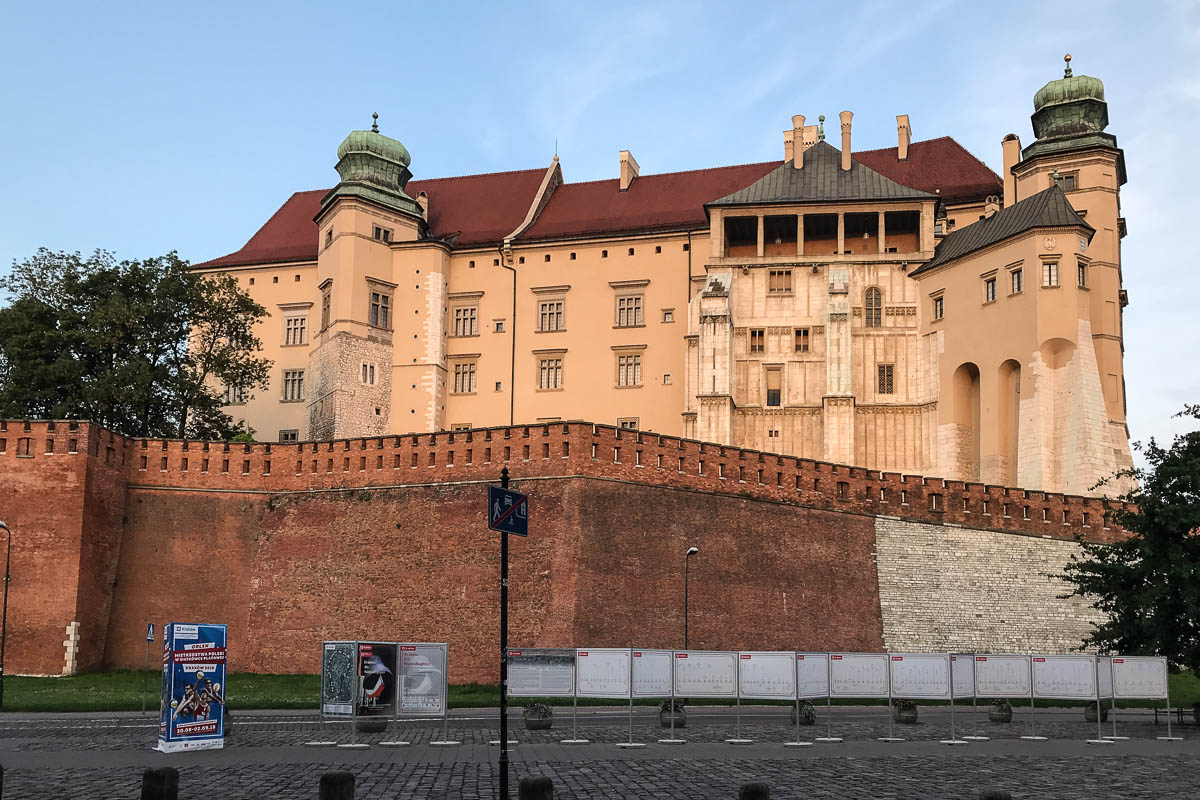
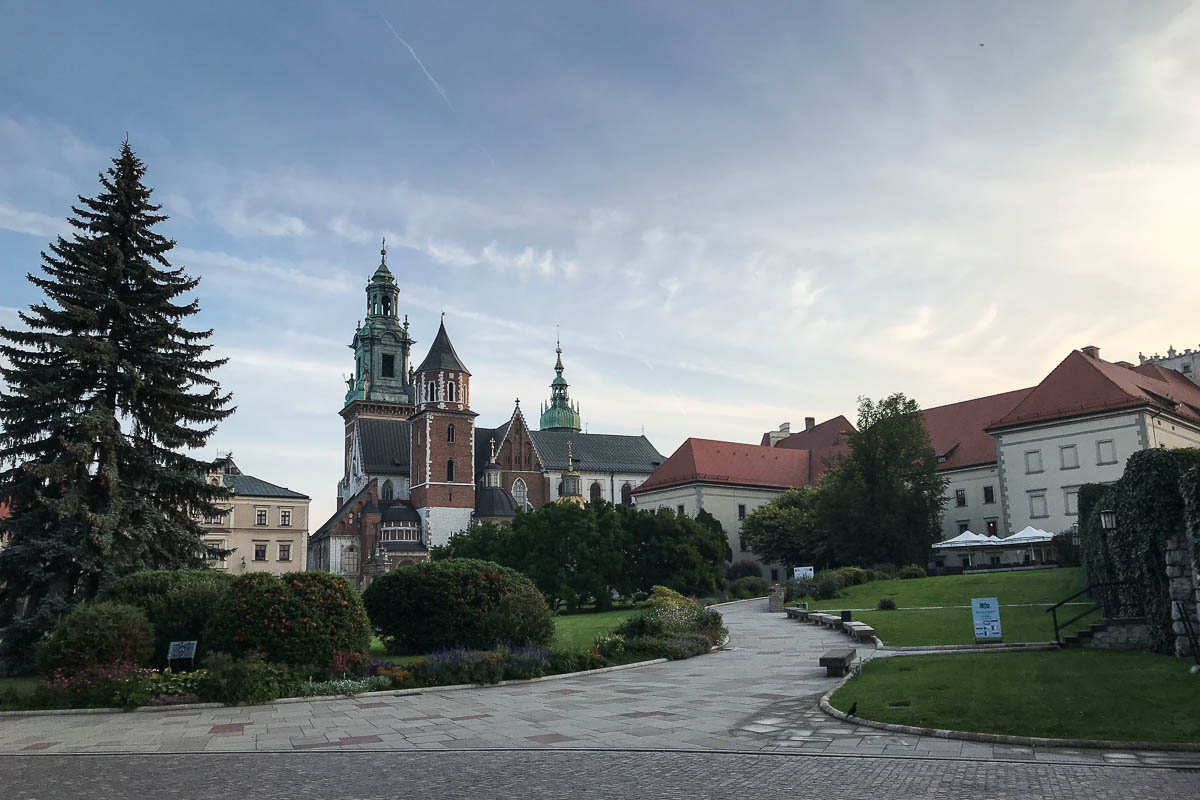

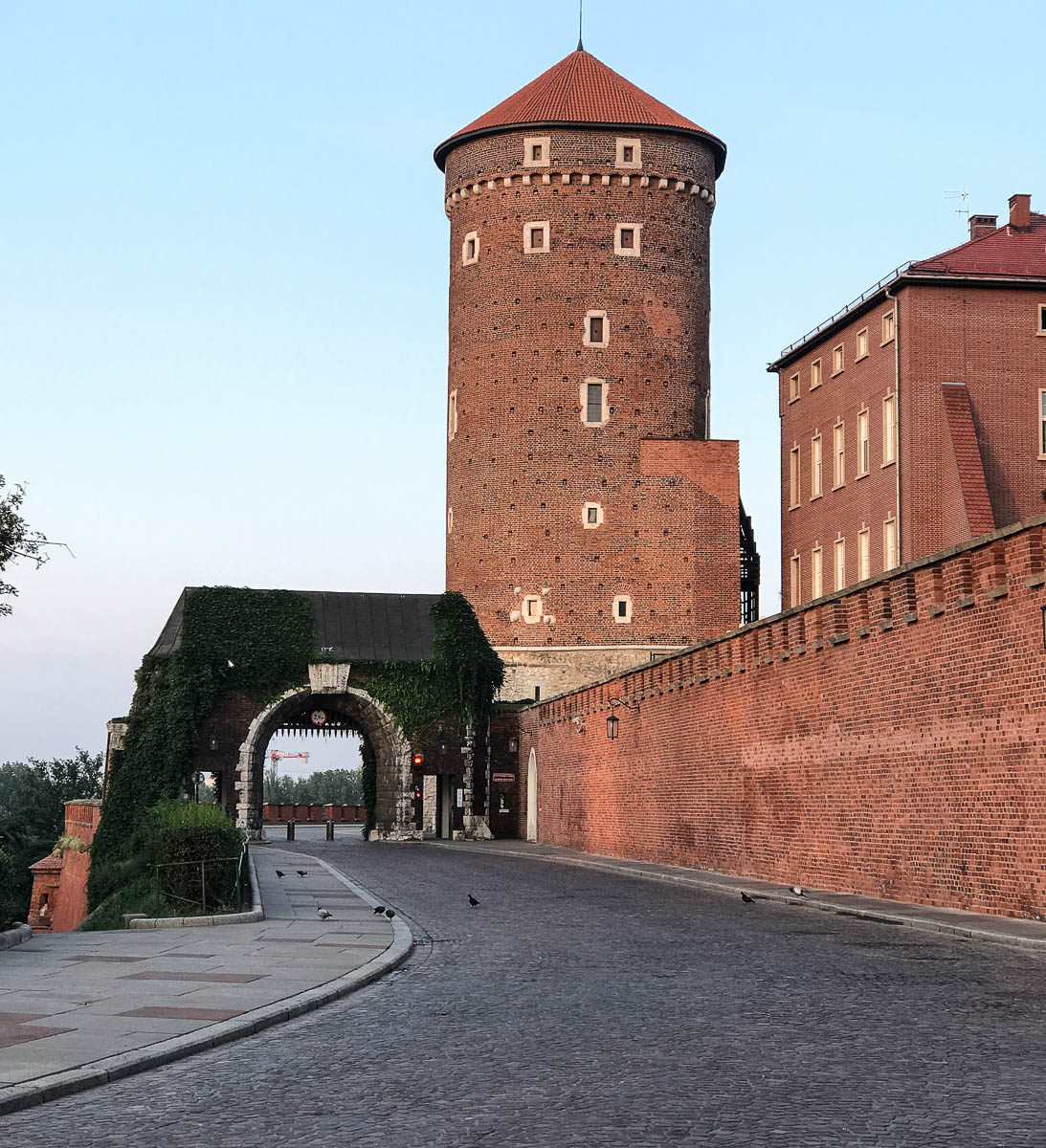
The Legend of the Dragon

This portion of the Planty lies along the Vistula River. Here we saw a statue of a dragon, the symbol of Krakow. The legend tells of a fierce dragon that lived below the castle. The king offered his scepter and crown and his daughter’s hand in marriage to whomever slayed the dragon. After many knights attempted and failed, a poor shoemaker killed the dragon. This clever young man created an explosive mixture placed inside a lambskin. He then placed it outside the dragon’s den during the night for the dragon’s breakfast.
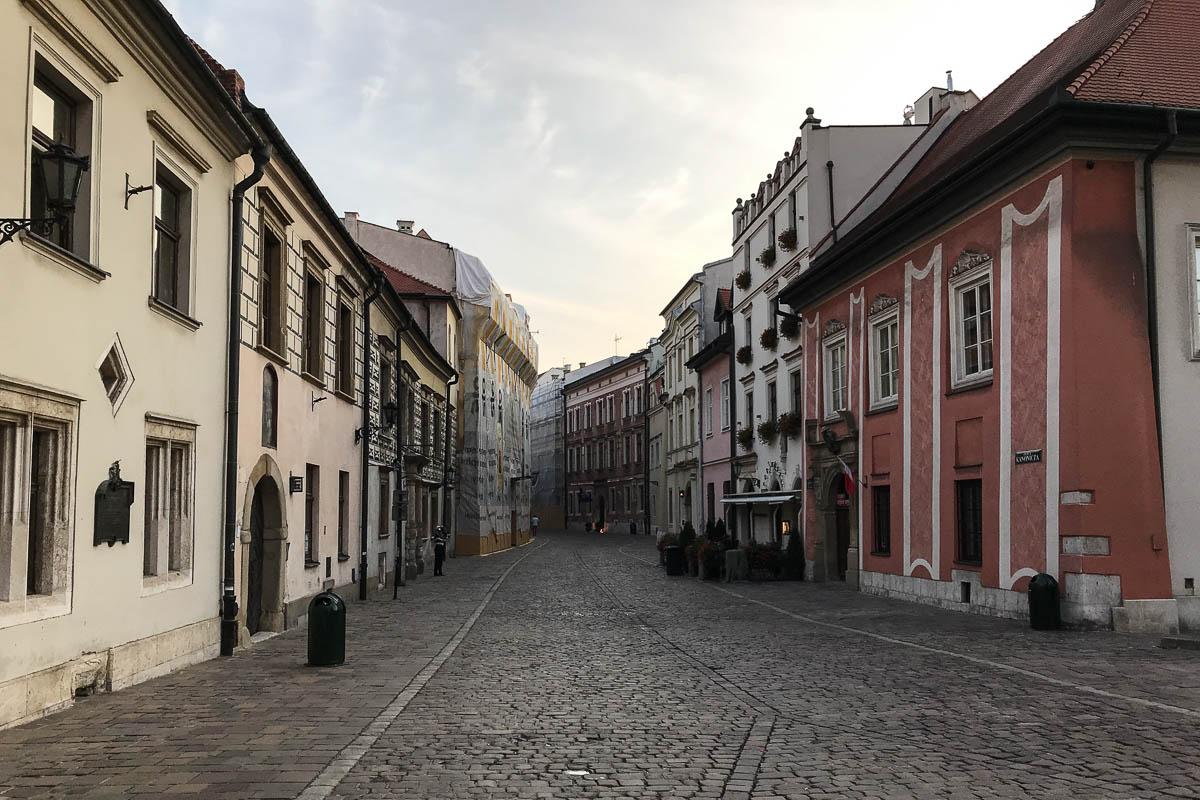
Throughout our tour of Old Town Krakow, we saw many more tourists than we expected. Ian went out at 5:30 one morning and redid the walk, taking pictures without most of the people. (This is the reason most of the pictures are devoid of the tourist crowds.)
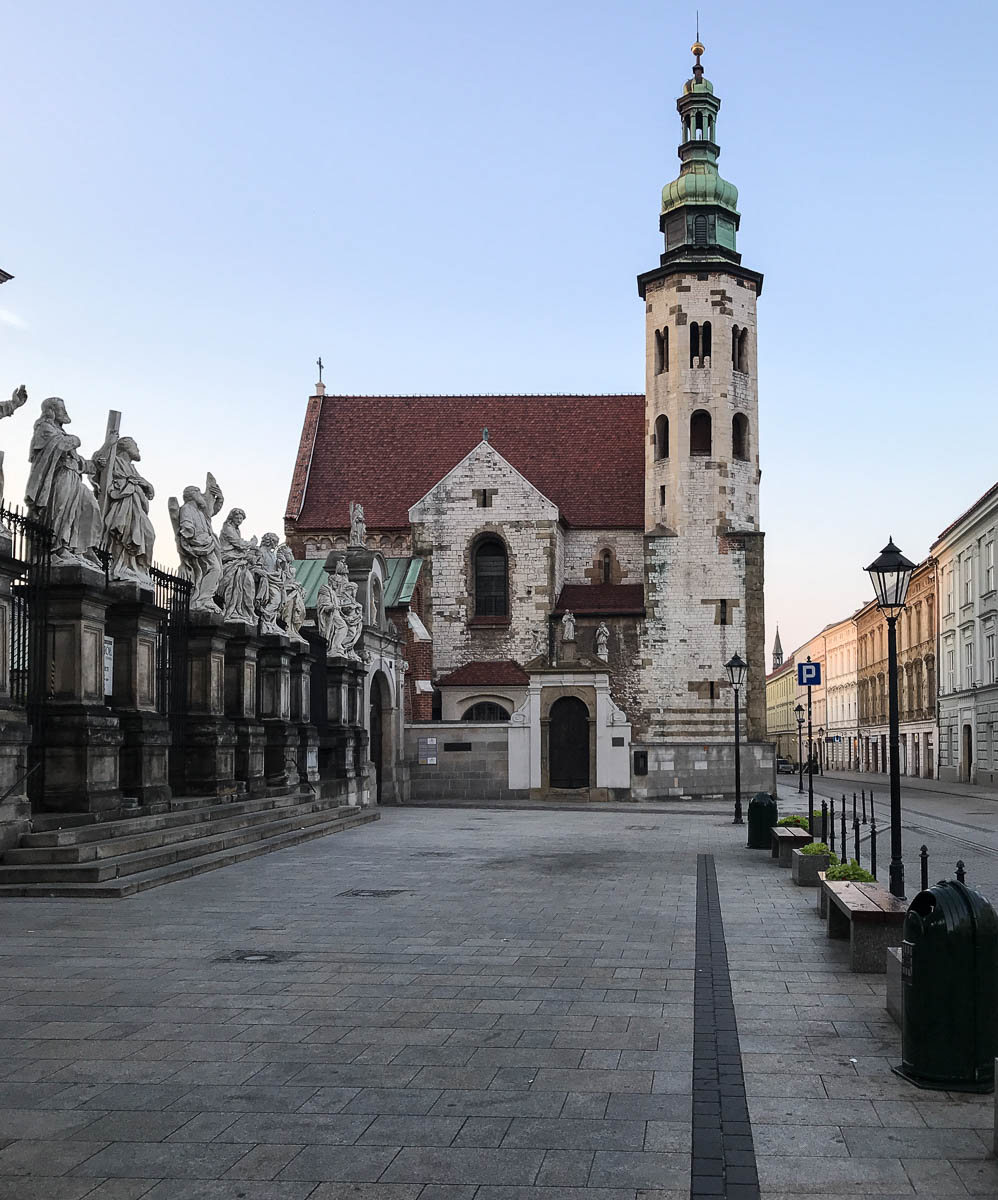
Jewish Krakow Walking Tour
The Jewish Krakow walking tour took us through the neighborhood of Kazimierz, across the Vistula River to the World War II ghetto, and ended at Schindler’s Factory. Although not as many sights to see, we learned much about the history of Jews in Krakow and Poland in general.
Historic Kazimierz

Kazimierz started as its own separate town, predominantly Catholic. Jews moved here after being kicked out from Prague. At the time, there was a larger Jewish settlement in Krakow. That ended when a church that was adjacent to the Jewish section of Krakow burned down, and the Jews were blamed for the fire. They were expelled from Krakow so took up residence in the neighboring Kazimierz. When Kazimierz later became part of the city of Krakow, this area became known as the Jewish section. Before World War II, Jews made up about 25% of Krakow’s population.
Kazimierz Today
About 20-30 years ago, Kazimierz was a derelict, addict-riddled area where no one ventured even during the day. After the fall of Communism, the neighborhood underwent a rebirth. It became an artistic community, filled with pubs, nightlife, and some of the best restaurants in town.
Kazimierz has quite a few old Jewish synagogues, but most of the cemeteries were destroyed during the war. Today, the neighborhood is home to an active Orthodox synagogue with a small number of congregants. Much more active is the Progressive synagogue and Jewish Community Center. Kazimierz hosts the annual week-long Jewish Culture Festival, one of the biggest parties in town.
Plac Nowy (New Square) in Kazimierz, site of the former market and slaughterhouse, is today a center of nightlife in Krakow. Surrounded by no fewer than eighteen pubs, it’s also probably the best place in town to get the local favorite “snack”, zapiekanki (we refer to it as ‘z’ and think of it as more of a meal). It’s basically half of an open-faced toasted baguette with toppings. The original is mushrooms and melted cheese but today the zapiekanki can be had with a huge variety of exotic toppings.
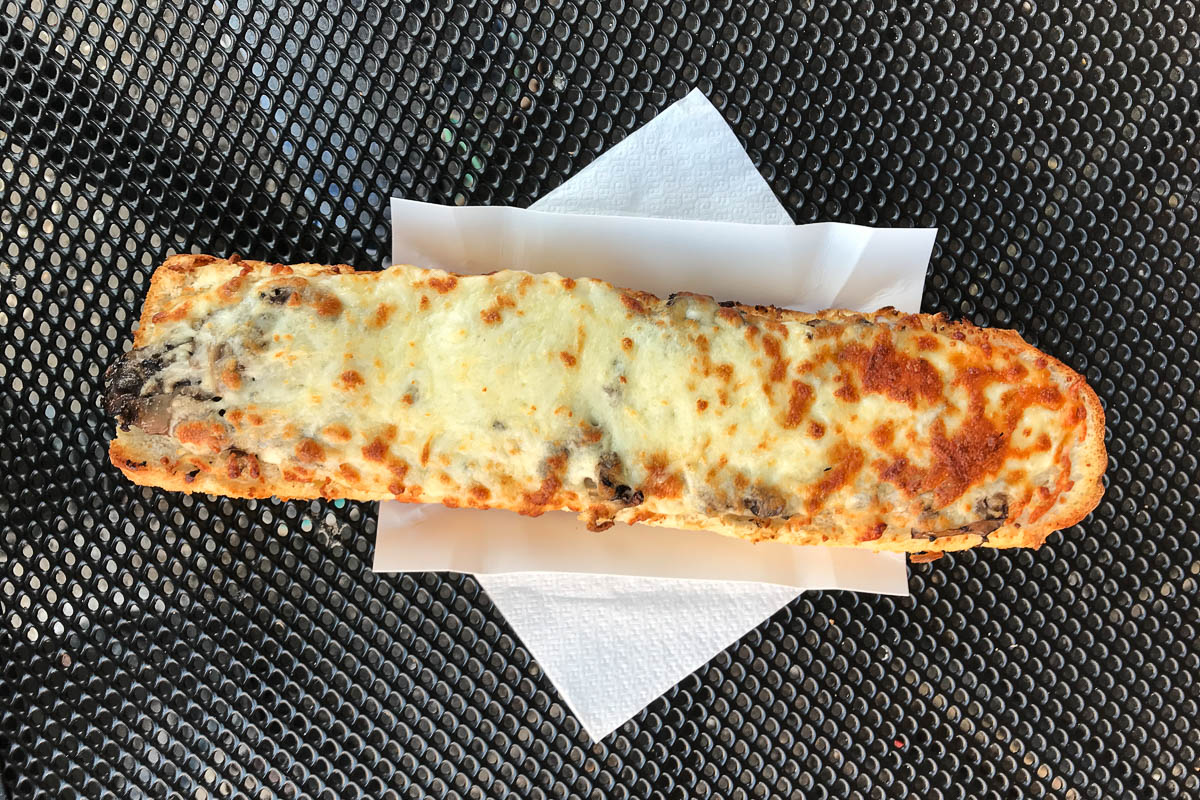
The Jewish Ghetto
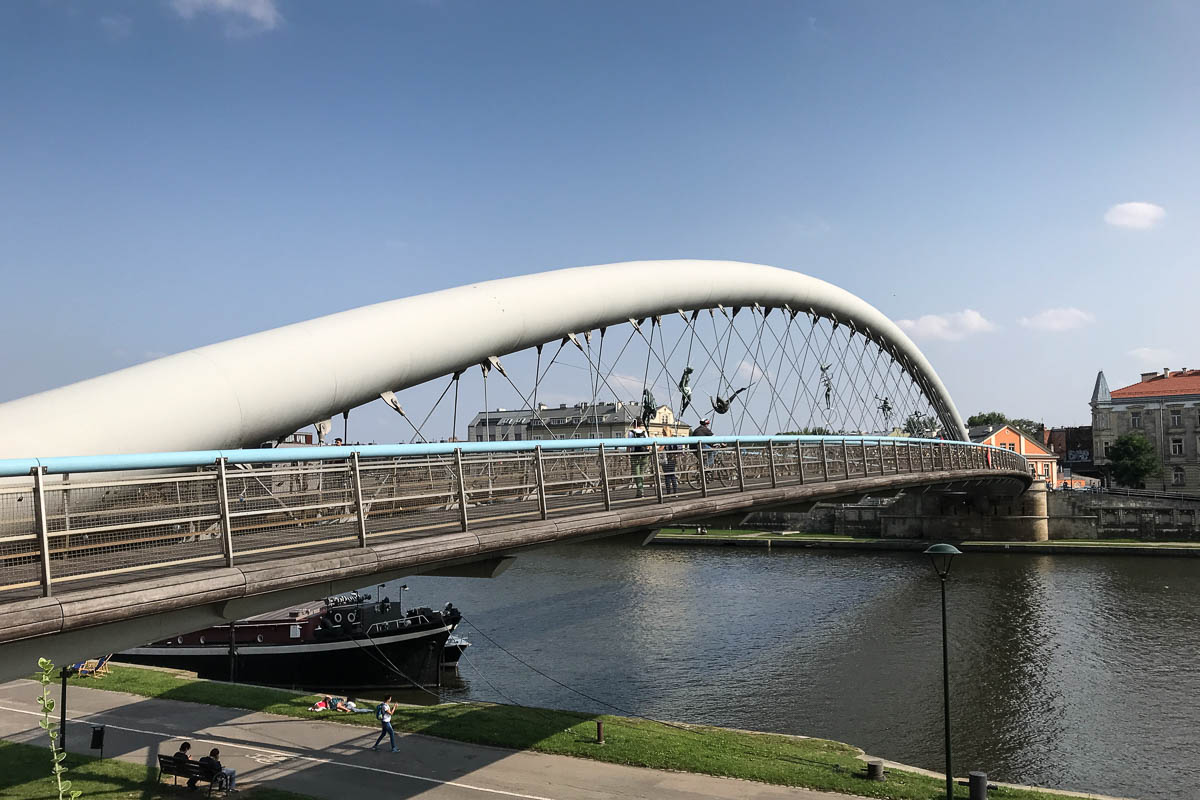
The industrial area of Krakow, Podgorze, was across the Vistula River from Kazimierz. It was here that the Jewish ghetto was established during World War II. The Nazis moved 36,000 Jews into an area that previously housed 3000. They were moved here to be close to the factories where they worked for free.
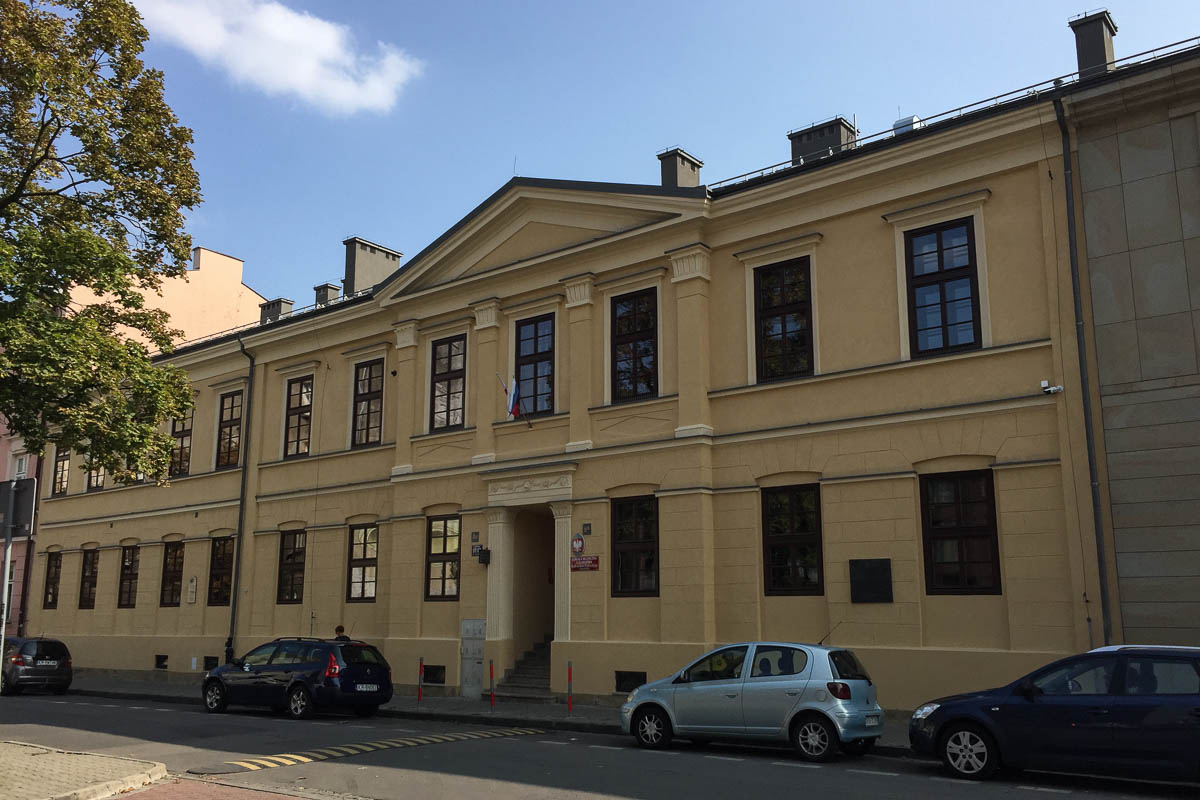
Ghetto Heroes Square
This square in the old Jewish Ghetto dates from the 1800’s. It was formerly home to a market before Podgorze became part of Krakow. Today, the otherwise empty square serves as a memorial with its 33 empty iron and bronze chairs, each chair representing 1000 people. It was here that the Jews of the ghetto were gathered before being loaded onto trains to the camps.

Schindler’s Factory
Our walking tour ended at the sight of Schindler’s Fctory, apparently one of the most visited sights in Krakow, most likely because of the film, “Schindler’s List”. All that remains of the factory is the original gate and the front office building. This building contains a museum, not about Schindler but about the history of World War II.
Some scenes from “Schindler’s List” were filmed here, but most were filmed on the other side of the river in Kazimierz. While on the ghetto side of the river, our guide showed us the spot where Roman Polanski reportedly escaped the ghetto at the age of ten.
Visit to Auschwitz-Birkenau
Since Auschwitz is almost two hours from Krakow, we decided against the public bus and trying to coordinate everything ourselves. Tours to Auschwitz-Birkenau book up in advance, so we ended up booking with Krakow Shuttle . This was one of the few companies that still had tours available that left Krakow at a reasonable time. We traveled in a van, door-to-door pickup and drop-off. When we arrived at Auschwitz, we joined other visitors to tour with a museum guide. We met back with the shuttle driver to take us to Auschwitz II/Birkenau to continue our tour with the same guide. The total cost for both of us (including an optional lunch to eat in the van on the way back) was 432 PLN* (about $114).
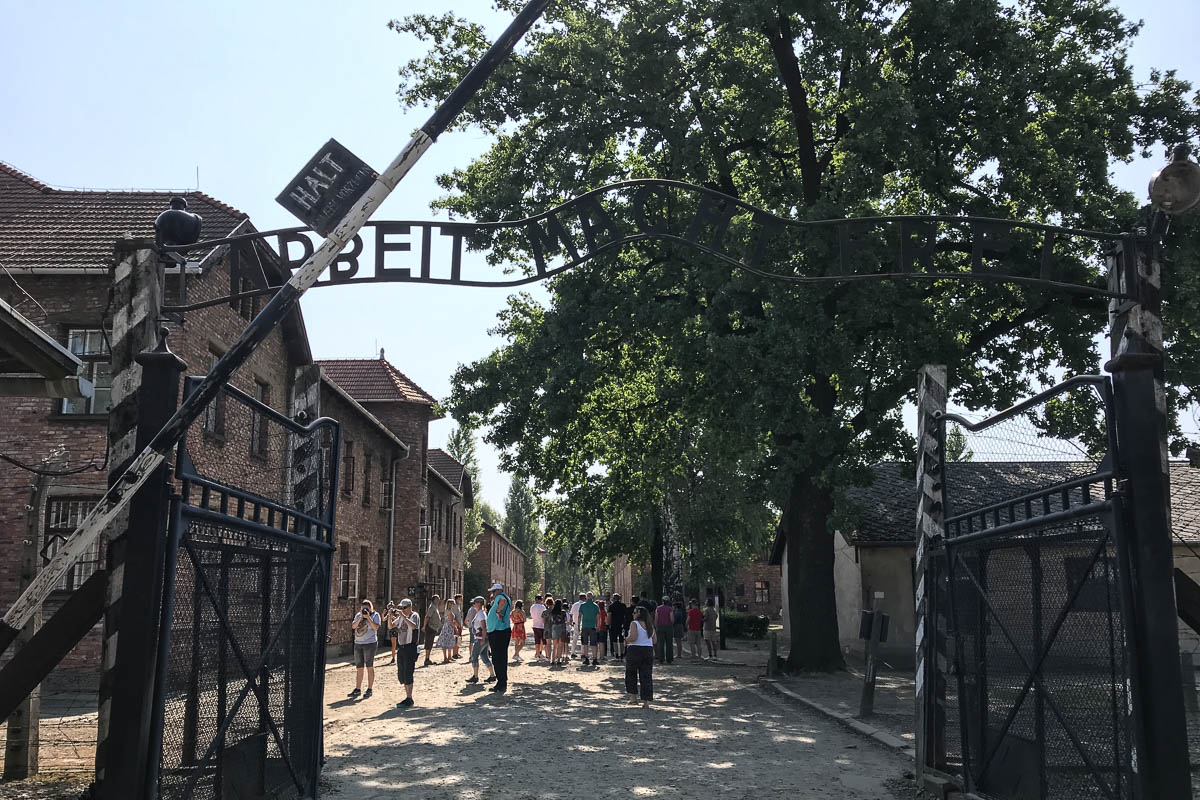
Auschwitz, on the site of old military barracks, originally functioned as a concentration camp. It later became an extermination camp, but it was too small to handle the increased numbers of people as part of the “Final Solution”.


The Nazis built Auschwitz II, aka Birkenau, for the primary purpose of extermination. The SS used people in the concentration camps as slave labor to build Birkenau.
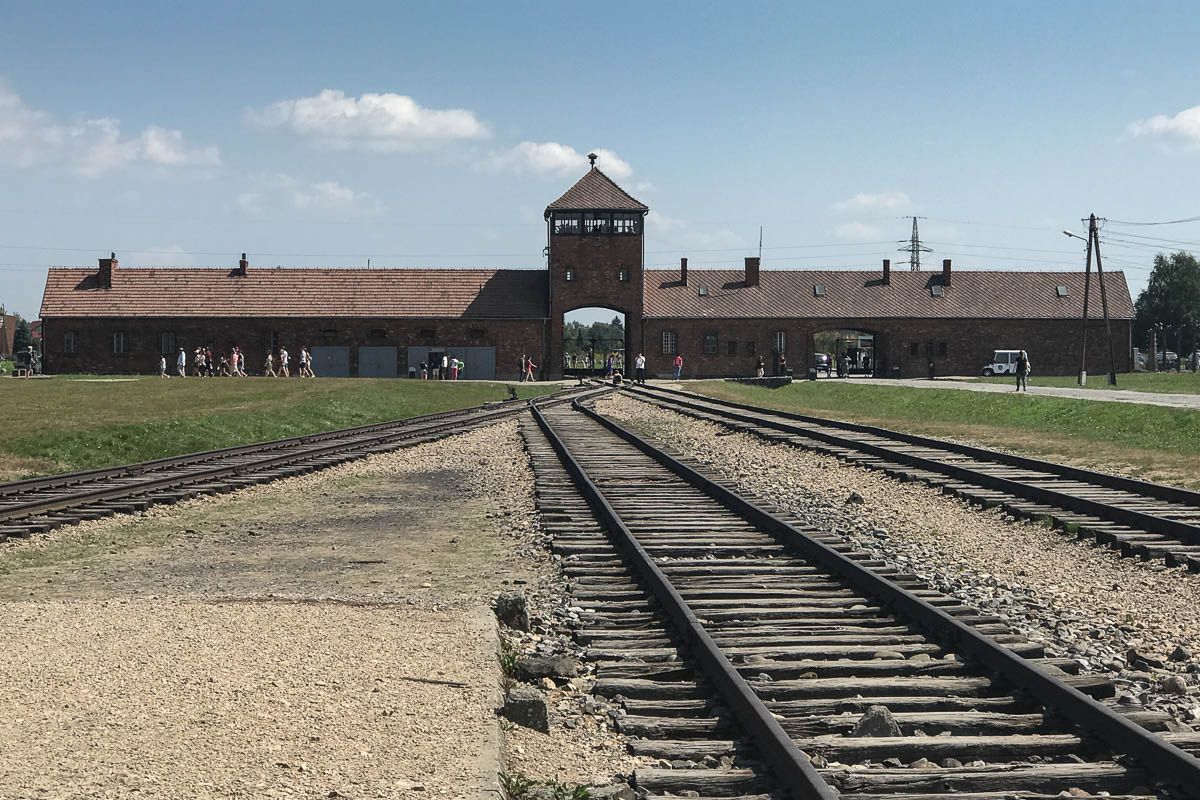
Soviet Allied forces approached the camp in January 1945. Before fleeing, the SS burned a large part of Birkenau in an attempt to destroy the evidence.

Rather than destroy the rest, the Polish people opened Auschwitz-Birkenau Memorial and Museum in 1947 as memorial to the victims and a reminder to the world. Over the years, many individuals and organizations, including the German government, have contributed to maintaining this important museum.
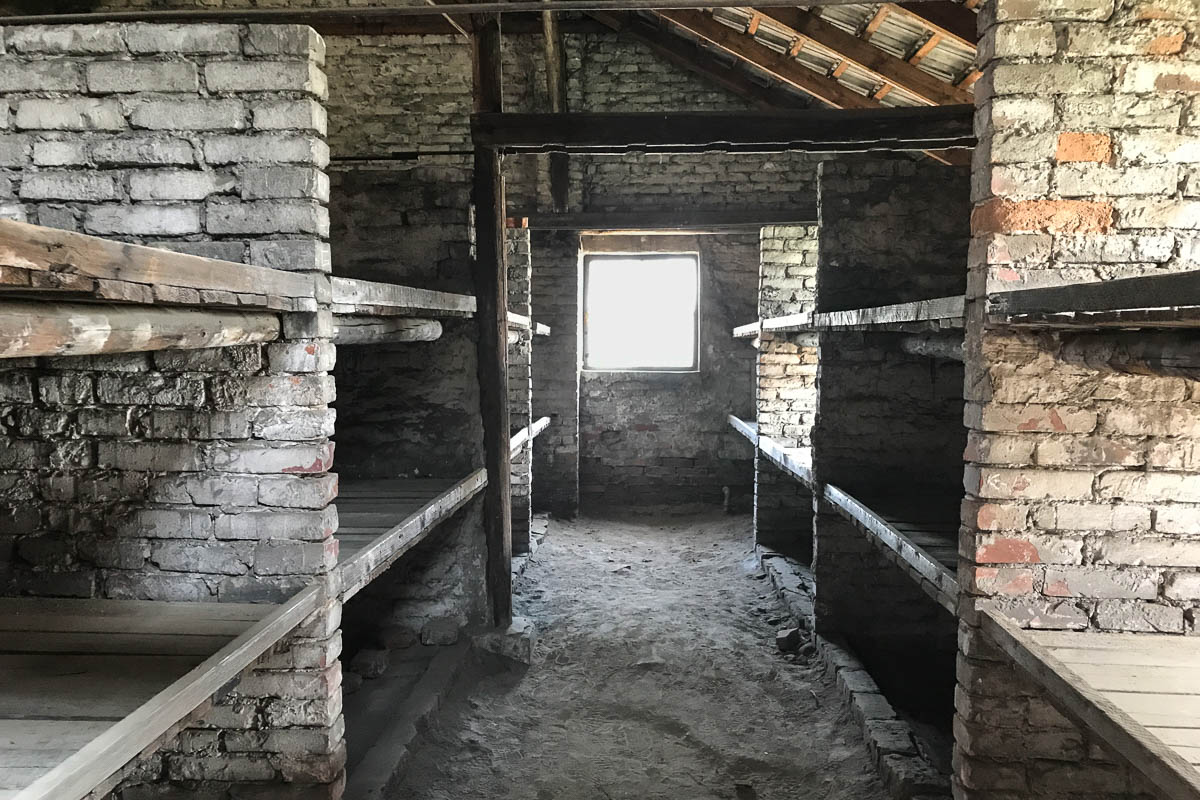
No amount of reading and research can truly prepare one for an actual visit to Auschwitz-Birkenau. The size and scope alone are beyond words. One can feel the spirits of those who perished there.
A Bit about Polish Food
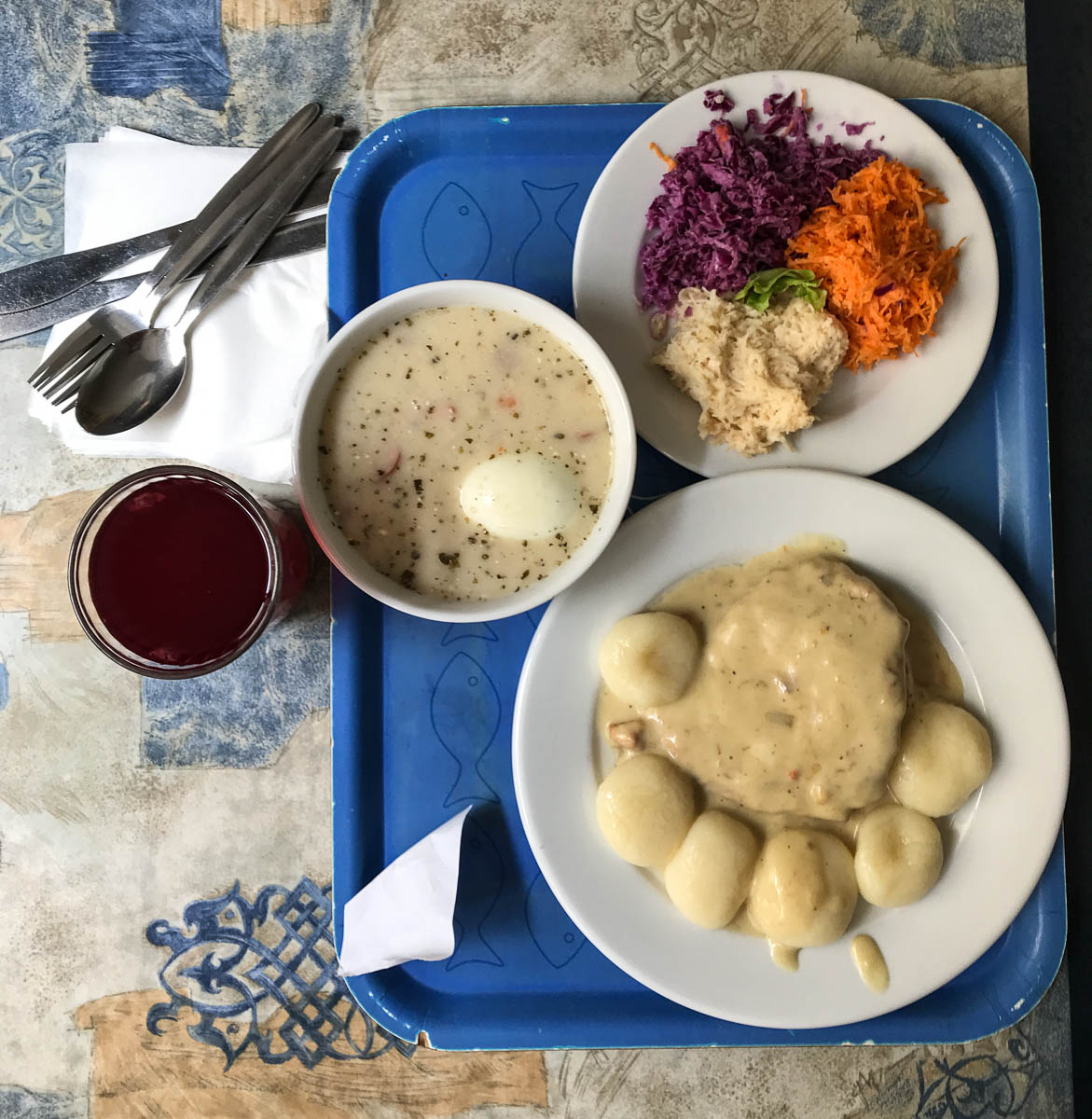
Polish cuisine has an emphasis on meat, particularly pork, often fried and breaded and covered in a colorless gravy. (We’re not complaining, that’s just how it is.) Common ingredients in Polish cooking include sausages, beetroot, sauerkraut, and mushrooms. Besides the favorite snack, zapiekanki (mentioned earlier), street corners in Krakow are filled with carts selling obwarzanki, ring-shaped bread. Obwarzanki can be plain or coated with seeds, such as poppy or sesame. And of course, there’s the pierogi.

Annual Pierogi Festival
We had the good fortune of being in Krakow for the 16th edition of the 5-day long Annual Pierogi Festival. The Small Market Square in the center of Old Town is filled with a stage and about a dozen temporary stalls selling all varieties of pierogi. The most typical fillings are: potato and sour cheese (ruskie), sometimes with onions added; mushrooms and sauerkraut; meat; and seasonal berries. But the festival is also a contest with two prizes, judges’ and peoples’ choice, for the most original flavor. At the festival, pierogi cost 2 -4 zl* each – we ate way too many! Ann’s favorite was spicy chicken with spinach. One of Ian’s favorites was curry.
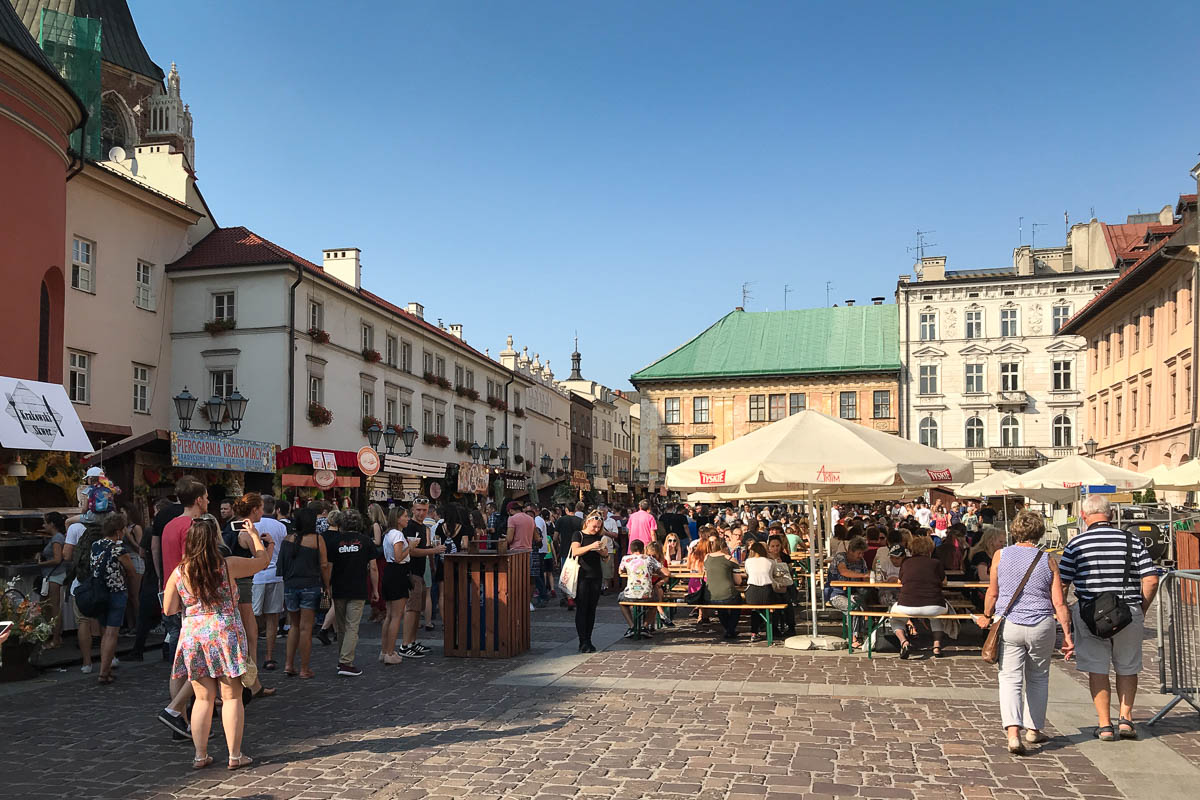
Apparently, there’s also an annual pierogi festival in Seattle. Ann (an admitted spelling fanatic), frustrated by pierogies (Canada) vs. pierogis (US), did further research to learn that in Polish, pierogi is plural. No singular form exists because nobody ever eats just one.
Poland Summary
What’s our overall impression of Poland? It’s a great place to visit but for us, not a place to live or spend an extended time. One main reason: the language. Since we left Spain, the languages have been getting increasingly more difficult. Polish is particularly challenging. We can’t imagine how it would have been if we had gone to a country with a Cyrillic Alphabet. After 90 days in Europe, the strains of being in countries without a shared language and culture were starting to wear. We were looking forward to being back in a country, i.e., Spain, where we at least stood a chance at making ourselves understood in the local language.
As a place to vacation, however, Poland is great: inexpensive and with lots of history. We neglected to mention an important bit of Polish history in our Warsaw post when discussing the POLIN Museum of the History of Polish Jews. In addition to presenting the history of the Jews in Poland, the museum also told Polish history, as the two are intertwined. Who knew that Poland used to be the biggest and richest country in Europe? It encompassed all of present day Poland, Ukraine, Belarus, and Lithuania.
Both cities we visited, Warsaw and Krakow, have excellent inexpensive public transportation, including trams and buses. Unlike Romania, drivers are less aggressive, almost always yielding to pedestrians. Krakow has its share of ugly Communist block towers, but they don’t seem as pervasive as in some other cities.
Brasov, Romania and Krakow, Poland are similar sized cities, with comparable prices. We prefer Brasov because it’s nestled in the mountains with a cooler summer climate. Krakow is flatter and doesn’t have the natural visual appeal that Brasov does.
Cost of Living
While not as inexpensive as Romania or Bosnia, the cost of living in Poland is quite reasonable. Krakow, however, is less expensive than Warsaw. We averaged $83 per day for two people including lodging, groceries, eating out (usually one meal a day every other day), attractions, and local transportation.
*At time of writing, 1 zl., Polish zloty (PLN), = $ .27
Next up: Back to Spain, First Stop: Las Palmas, Gran Canaria
Ian & Ann

16 Comments
Thanks for sending more amazing pics. Krakow is an lovely city. I also visited Auschwitz and
left in tears.
Best,
Marge
Hi Marge,
Yes, we definitely liked Krakow, and we feel Auschwitz is a must visit for anyone in the area.
Ian & Ann
I didn’t realize you are still in Europe until I received this.
Hi Art,
Yes, we’re here, in Spain, until October 3rd.
Ian & Ann
So very interesting, Thank you so much for posting.Almost feel like I’m having the experience.
Hi Karen,
That’s what we like to hear. 🙂
Ian & Ann
Another amazing read!
Hi Carrie,
Like we said before, that’s what we like to hear. 🙂
Ian & Ann
love following you around, now i kind of know where we want to go on our next vacation. thinking Berlin, copenhagen (our nephew is going to school there) or maybe Prague or Amsterdam. got a few months to figure this out……been to any?
Hi Michelle,
Ian was in Amsterdam twice about 20 years ago, says great city, easy to get around. If you want to stay outside the city, he recommends Harlem (mini Amsterdam), 15 minute train ride. He also recommends the Van Gogh Museum. He also liked the outdoor folk museum about 30 minutes outside of town.
We’ve both been to Prague about 5 years ago and really liked it. We were there in June and it wasn’t overly crowded. We enjoyed wandering around town and attending one of the many inexpensive classical music concerts. We stayed outside of town in an apartment in a local neighborhood.
We haven’t been to Berlin or Copenhagen.
Ian & Ann
Glad everything worked out in Poland and you were able to maneuver your ways around it even with the language barrier. As always your posts are so informative and entertaining and why am i craving a pretzel now? Hehe enjoy and keep those pictures coming. Blessings for both !
Hi Araceli,
Yes, Spanish is a piece of cake compared to Polish. Have to admit, Ann couldn’t resist the pretzels in Poland and Romania, and especially the pretzel sticks from our favorite bakery in Sarajevo.
Ian & Ann
Reading and seeing the Polish food made me so hungry! I regret all those years I was so picky and wouldn’t eat my Polish grandma’s home cooking 😫
Hi Sam,
Guess then it doesn’t matter that we forgot to ask you for food recommendations. We didn’t mention it in our post, but we cooked and enjoyed lots of Kielbasa while in Krakow.
Ian & Ann
I loved Krakow when I was there on a chorus tour, Also went to Auschwitz which was very sad and frightening. Loved your descriptions and photos.
Hi Ellie,
Your use of the word, frightening, caught my attention and got me thinking and reflecting some more. Thank you.
Ann